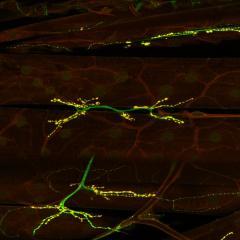Topics
An international collaboration discovers novel neurodevelopmental syndrome

HOUSTON, TX - An international study led by researchers at Baylor College of Medicine, Texas Children’s Hospital and Hunan Provincial Maternal and Child Health Care Hospital in China identified spontaneous point mutations in a cyclin-dependent kinase 19 (CDK19) gene, which causes a novel early-onset neurodevelopmental disorder characterized by uncontrolled early-onset seizures. The study provides the first experimental evidence that links mutations in the CDK19 gene to a human disorder. It appears in American Journal of Human Genetics.
Epileptic syndromes in infants, termed “infantile spasms”, are a symptom of generalized brain dysfunction and occur due to genetic disorders or infections that usually begin in the first two years of life, commonly between 4 and 8 months of age. For most patients, the overall prognosis is poor. The study addresses an urgent need for identifying new “druggable” molecular targets for infantile spasms.
The multi-institutional effort was led by Dr. Hugo J. Bellen, professor at Baylor, and investigator at the Jan and Dan Duncan Neurological Research Institute at Texas Children’s and Howard Hughes Medical Institute (HHMI), and Dr. Bo Xiao, professor at the Xiangya Hospital, Central South University in China.
“This project originated when Dr. Xiao Mao who is the co-first author in this study, contacted the Bellen lab to collaborate with two medical mystery cases. We realized that their clinical symptoms closely resembled those of a patient being cared for by Dr. Carlos Bacino, chief of Genetics Services at Texas Children’s Hospital and professor at Baylor,” Bellen, one of the corresponding authors, said. “Upon further examination, we found all of them had severe and frequent uncontrolled seizures with severe developmental delays, including impaired motor, speech, and intellectual abilities. Upon comparing the genomes of these patients and their parents, we found non-familial point mutations in the CDK19 gene of the patients. The mutations had occurred in the germline cells of the parents, and two of the affected individuals had identical amino acid change in one copy of the gene.”
CDK19 binds with three other proteins - cyclin C, Mediator 12 (MED12), and Mediator 13 (MED13) - to form a large CDK module that regulates the expression and activity of many genes. While mutations in MED12 and MED13 have been linked to intellectual disability, but until this study, loss or dysfunction of the Cdk19 gene was not associated with any human disease or neurological condition.
To further explore if and how Cdk19 mutants found in the patients behave different from the normal Ckd19, the researchers turned to fruit flies.
First, they generated transgenic flies that expressed the normal and mutated human versions of Cdk19. Flies expressing normal human Cdk19 did not affect the viability of the flies, whereas flies that expressed the mutated versions had significantly reduced viability.
Next, they asked if human Cdk19 and its variants are able to functionally replace the cdk8 gene, the closest version of this gene in fruit flies. To do this, they expressed normal and mutant versions of human Cdk19 in flies lacking cdk8. Typically, deleting both copies of cdk8 or its reduction in the neurons causes lethality. However, when normal human version of Cdk19 was expressed in cdk8 mutant flies, the flies survived to adulthood. On the other hand, flies expressing mutant versions of Cdk19 still died as larvae - a clear demonstration that the two Cdk19 missense mutants act as loss-of-function variants.
“Since all three patients exhibited intractable epilepsy, we next performed the ‘bang sensitivity’ assay, which is used to induce seizure-like behavior in flies. In this assay, flies are subjected to vigorous mechanical stress and then observed for the time it takes for them to regain balance. Normal flies are able to right themselves within a few seconds. However, flies that are sensitive to mechanical stress exhibit a stereotypical pattern of shaking and paralysis that lasts longer. Consistent with the symptoms in patients, young flies in which cdk8 was specifically reduced in the neurons took about 45 seconds to recover, ten times longer than control flies,” Dr. Hyunglok Chung, an HHMI postdoctoral fellow in the Bellen lab and lead author of the study, explained. “Interestingly, expression of the normal version of human Cdk19 significantly reduced the recovery time while expression of the disease-causing mutants did not.
Finally, they asked whether the seizures were associated with neurodevelopmental defects. To test this, they analyzed the neuromuscular junction (NMJ), a well-established model for studying the synapses - junctions that connect and facilitate communication between neighboring neurons or neurons and muscles. Surprisingly, they found specific reduction of cdk8 from the neurons significantly reduced the number of NMJ synapses, suggesting defects in neuronal communication might be the primary underlying cause for the poor muscle tone, and the cognitive and motor impairments observed in patients”.
In summary, the team identified a novel Cdk19–mediated neurodevelopmental syndrome.
“With this study we are a step closer to finding a mechanism and possible therapeutic target for early-onset epilepsy and intractable seizures, which we hope will not only help patients with this novel condition but might also prove beneficial for patients with other early-onset epileptic encephalopathies,” Mao concluded.
Other authors involved in the study include Hua Wang, Ye-Jin Park, Paul C. Marcogliese, Jill A. Rosenfeld, Lindsay C. Burrage, Pengfei Liu, David R. Murdock,
Shinya Yamamoto, Michael F. Wangler, Undiagnosed Diseases Network, Hsiao-Tuan Chao, Hongyu Long, and Li Feng. They are affiliated with one or more of these institutions: Baylor College of Medicine, Texas Children’s Hospital, Hunan Provincial Maternal and Child Health Care Hospital, China; Xiangya Hospital, Central South University, China; and The Robert and Janice McNair Foundation. See the publication for the funding sources.





